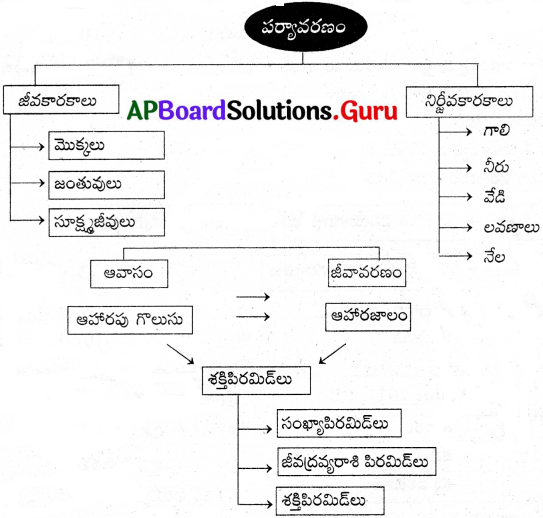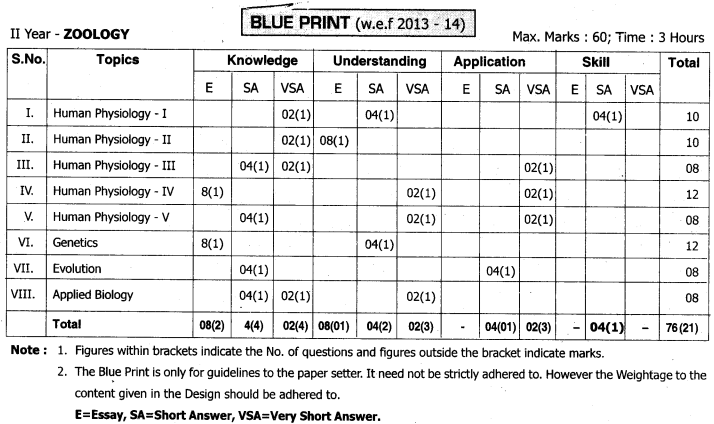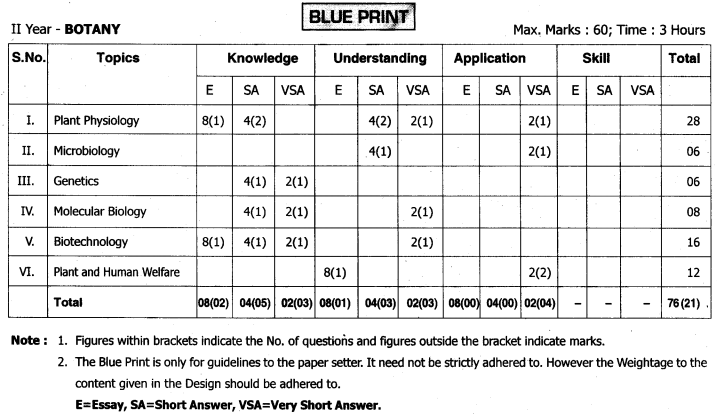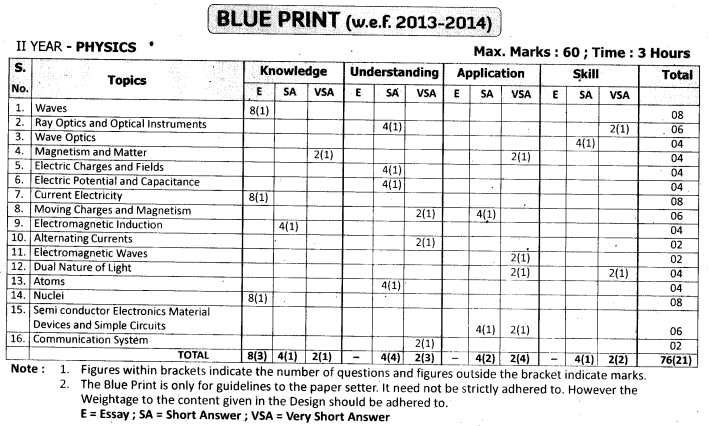These AP 10th Class Biology Important Questions 9th lesson మన పర్యావరణం – మన బాధ్యత will help students prepare well for the exams.
AP Board 10th Class Biology 9th lesson Important Questions and Answers మన పర్యావరణం – మన బాధ్యత
10th Class Biology 9th lesson మన పర్యావరణం – మన బాధ్యత 1 Mark Important Questions and Answers
ప్రశ్న 1.
ఆహారపు జాలకం నుండి విచ్ఛిన్నకారులను తొలగిస్తే ఏమవుతుంది?
జవాబు:
ఆహారపు జాలకం నుండి విచ్ఛిన్నకారులను తొలగిస్తే జీవరసాయన వలయాలు భర్తీ కావు. జీవులలోని సేంద్రియ పదార్థాలు నిరీంద్రియ పదార్థాలుగా మారవు.
ప్రశ్న 2.
క్రింది వానిని పరిశీలించి సంఖ్యా పిరమిడ్ చిత్రం గీయండి.
గడ్డి – మేక – మానవుడు,
జవాబు:
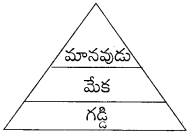
ప్రశ్న 3.
పిచ్చుకలు లేని ప్రపంచాన్ని ఊహించలేం. వాటి సంరక్షణ పట్ల మన ప్రవర్తన ఎలా ఉండాలి?
జవాబు:
- క్రిమిసంహారక మందుల వినియోగం తగ్గించాలి.
- సెల్ టవర్ రేడియేషన్ తగ్గించాలి.
- జైవిక నియంత్రణ పద్ధతులు పాటించాలి.
- పక్షుల సంరక్షణ కేంద్రాలను నెలకొల్పాలి.
ప్రశ్న 4.
మీ పరిసరాలలో మీరు గమనించిన ఒక ఆహారపు గొలుసును గుర్తించి, దానిలోని ఉత్పత్తిదారుల మరియు వివిధ స్థాయిలలో గల వినియోగదారుల పేర్లు వ్రాయండి.
జవాబు:
గడ్డి → కీటకాలు → కప్ప → పాము
ఉత్పత్తిదారులు – గడ్డి
ప్రాథమిక వినియోగదారులు – కీటకాలు
ద్వితీయ వినియోగదారులు – కప్ప
తృతీయ వినియోగదారులు – పాము
నీటిమొక్కలు → కీటకాలు → చేప → కొంగ
ఉత్పత్తిదారులు – నీటిమొక్కలు
ప్రాథమిక వినియోగదారులు – కీటకాలు
ద్వితీయ వినియోగదారులు – చేప
తృతీయ వినియోగదారులు – కొంగ
![]()
ప్రశ్న 5.
మీకు తెలిసిన ఆహారపు గొలుసులోని ఉత్పత్తిదారులు మరియు వినియోగదార్ల పేర్లను రాయండి.
జవాబు:
ఉత్పత్తిదారులు – మొక్కలు, ఆకుపచ్చ శైవలాలు
వినియోగదారులు – అన్ని రకాల జంతువులు
ప్రశ్న 6.
“కీటకాలు, పక్షులు లేని ప్రపంచాన్ని మనం ఊహించలేము.” వాటిని సంరక్షించుటకు మీరు పాటించే రెండు పద్ధతులను తెలుపండి.
జవాబు:
- క్రిమి సంహారక మందులను అతిగా వాడకూడదు.
- కీటకాల మరియు పక్షుల సహజ ఆవాసాలను కాపాడాలి.
- పార్కులను మరియు పక్షుల సాంక్చ్యురీలను అభివృద్ధి చేయాలి.
- ప్రతి ఒక్కరూ తప్పనిసరిగా పర్యావరణ సూత్రాలను పాటించే విధంగా చైతన్య పరచాలి.
ప్రశ్న 7.
క్రింది ఆహార పిరమిడను గమనించండి. క్రింద ఇవ్వబడిన ప్రశ్నలకు సమాధానాలు రాయండి.
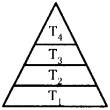
i) ఏ పోషక స్థాయిలో అధిక శక్తి ఉంటుంది?
ii) T4 పోషక స్థాయికి ఒక ఉదాహరణ రాయండి.
జవాబు:
i) T1 (లేదా) ఆకుపచ్చ మొక్కలు (లేదా) ప్రాథమిక ఉత్పత్తిదారులు. –
ii) సింహము, పులి, డేగ మొ||నవి.
ప్రశ్న 8.
పర్యావరణ స్నేహపూర్వక కార్యక్రమాలపై అవగాహన కల్పించుటకు ఏవైనా రెండు నినాదాలను వ్రాయండి.
జవాబు:
- పచ్చదనాన్ని పెంచు – భూగోళాన్ని శుభ్రంగా ఉంచు.
- ప్రకృతిని నీవు నాశనం చేస్తే – ప్రకృతి నిన్ను నాశనం చేస్తుంది.
- కాలుష్య నివారణకు ఉత్తమ మార్గం – మొక్కల పెంపకం.
- ప్లాస్టిక్ వాడకాన్ని తగ్గిద్దాం – కాలుష్యాన్ని తగ్గిద్దాం.
ప్రశ్న 9.
హరితహారంలో భాగంగా మీ పాఠశాలలో నాటిన మొక్కలను సంరక్షించటానికి మీరు ఏ చర్యలు తీసుకొంటారు?
జవాబు:
- మొక్కలకు నీటిని సరఫరాచేయటం,
- కంచె వేయటము (లేదా) మొక్కల సంరక్షణ,
- మొక్కలను దత్తత తీసుకోవటం,
- సహజ ఎరువులను సరఫరా చేయటము.
ప్రశ్న 10.
జీవావరణం అనగానేమి?
జవాబు:
భూమి మీద జీవులు నివసించటానికి యోగ్యమైన ప్రదేశం అంతా ‘కలిపి ‘జీవావరణం’ అంటారు. ఇది అనేక ఆవరణ వ్యవస్థల సమూహం. అతి పెద్ద ఆవాసంగా కూడా జీవావరణాన్ని పరిగణించవచ్చు.
ప్రశ్న 11.
పోషకస్థాయి అనగానేమి?
జవాబు:
ఆహారపు గొలుసులో ప్రతి స్థాయి వద్ద లభించే పోషక విలువను పోషకస్థాయి అంటారు. సాధారణంగా ఆహార గొలుసులో పోషకస్థాయి వద్ద 10 నుండి 20 శాతం శక్తి బదిలీ జరుగుతూ ఉంటుంది.
ప్రశ్న 12.
పర్యావరణం అనగానేమి?
జవాబు:
పర్యావరణం:
జీవజాలం మీద ప్రభావం చూపే జీవభౌతిక కారకాలతో పాటు, రసాయనిక కారకాలన్నింటితో గల పరస్పర సంబంధాన్ని “పర్యావరణం” (Environment) అంటారు.
![]()
ప్రశ్న 13.
పర్యావరణంలోని నిర్జీవ కారకాలు ఏమిటి?
జవాబు:
నిర్జీవ కారకాలు :
పర్యావరణంలో గాలి, నీరు, నేల, కాంతి మొదలైన నిర్జీవ కారకాలను “భౌతిక కారకాలు” అంటారు.
ప్రశ్న 14.
పర్యావరణంలోని జీవకారకాలు ఏమిటి?
జవాబు:
జీవకారకాలు :
పర్యావరణంలోని మొక్కలు, జంతువులు, సూక్ష్మజీవులను కలిపి “జీవకారకాలు’ అంటారు.
ప్రశ్న 15.
ఆహార గొలుసు అనగానేమి?
జవాబు:
ఆహార గొలుసు:
జీవుల మధ్య ఉండే ఆహార సంబంధ వరుస క్రమాన్ని ఆహార గొలుసు అంటారు.
ప్రశ్న 16.
ఆహార జాలకం అనగానేమి?
జవాబు:
ఆహార జాలకం :
అనేక ఆహారపు గొలుసుల కలయికను ఆహార జాలకం అంటారు. ఇది ఆహార గొలుసుల మధ్యగల సంబంధాన్ని చూపుతుంది.
ప్రశ్న 17.
ఆహారపు గొలుసులోని స్థాయిలను తెలపండి.
జవాబు:
ఆహారపు గొలుసులో కింది స్లాయిలు ఉంటాయి.

ప్రశ్న 18.
ఆహార గొలుసుకు ఉదాహరణ ఇవ్వండి.
జవాబు:
1. గడ్డి → మిడత → కప్ప → పాము → గద్ద
2. గడ్డి → కుందేలు → నక్క → తోడేలు
3. గడ్డి → మేక → మానవుడు
ప్రశ్న 19.
ఆహారపు గొలుసులో శక్తి బదిలీ జరిగేటప్పుడు జరిగే నష్టమెంత?
జవాబు:
ఆహారపు గొలుసులో శక్తి బదిలీ జరిగేటప్పుడు 80 నుండి 90% శక్తి వృథా అవుతుంది. ఇది శ్వాసక్రియలోనూ, ఇతర క్రియల ద్వారా ఉత్పత్తి అయిన ఉష్ణరూపంలో నష్టపోవటం జరుగును.
ప్రశ్న 20.
భౌమ ఆవరణ వ్యవస్థలోని వ్యత్యాసాలకు కారణాలు ఏమిటి?
జవాబు:
భూమధ్యరేఖకు, ధృవాలకు మధ్యగల శీతోష్ణస్థితిలోని వ్యత్యాసాలే భౌమ్యావరణ వ్యవస్థలను నిర్ధారిస్తాయి.
ప్రశ్న 21.
కొల్లేరు సరస్సులోనికి ఎక్కువ పోషకాలు కలిగిన వ్యర్థాలు ఎలా చేరుతున్నాయి?
జవాబు:
కొల్లేరు పరీవాహక ప్రాంతాలను వ్యవసాయ భూములుగా మార్చి అధిక మోతాదులో రసాయనిక ఎరువులు వాడుతున్నారు. రసాయనిక ఎరువులు కలిగిన ఈ నీరు సరస్సులోనికి చేరి కలుషితం చేస్తుంది.
ప్రశ్న 22.
నిచ్ (Niche) అనగానేమి?
జవాబు:
నిచ్ : ప్రతి జంతువు ఆహార జాలకంలో ఒక నిర్దిష్ట స్థానాన్ని కలిగి ఉంటుంది. దీనిని ఆ జంతువు యొక్క ‘ఆహార జాలకపు ఆవాహం ‘ లేదా ‘నిచ్’ అంటారు.
ప్రశ్న 23.
జీవావరణ పిరమిడ్ అనగానేమి?
జవాబు:
జీవావరణ పిరమిడ్ :
జీవుల మధ్య సంబంధాలను చూపడానికి లేదా వర్ణించటానికి, ఆవరణ శాస్త్రవేత్తలు ‘పిరమిడ్’ అనే భావనను ఉపయోగించారు. వివిధ పోషకస్థాయిలలో ఆవరణ వ్యవస్థ యొక్క నిర్మాణాన్ని ‘పిరమిడ్’ రూపంలో రేఖాత్మకంగా చూపే చిత్రాన్ని “జీవావరణ పిరమిడ్” (Ecological pyramid) అంటారు.
ప్రశ్న 24.
ఆవరణశాస్త్ర పిరమిడ్ లోని రకాలు తెలపంది.
జవాబు:
ఆవరణ శాస్త్ర పిరమిడ్లు మూడురకాలు :
- సంఖ్యాపిరమిడ్లు
- జీవద్రవ్యరాశి పిరమిడ్లు
- శక్తి పిరమిడ్లు
ప్రశ్న 25.
సంఖ్యాపిరమిడ్ అనగానేమి?
జవాబు:
ఆహారపు గొలుసులోని జీవులను సంఖ్యాత్మకంగా చూపించే పిరమిడను “సంఖ్యాపిరమిడ్” అంటారు.
![]()
ప్రశ్న 26.
జీవద్రవ్యరాశి అనగానేమి?
జవాబు:
శక్తిగా మార్చడానికి వీలైన వృక్ష, జంతు సంబంధ పదార్థాన్ని “జీవద్రవ్యరాశి” అంటారు. జీవద్రవ్యరాశిని శక్తి ఉత్పత్తికోసం వినియోగిస్తే అది జీవశక్తి (Biofuel) అవుతుంది.
ప్రశ్న 27.
జీవద్రవ్యరాశి పిరమిడ్లు ఎలా ఉంటాయి?
జవాబు:
జీవద్రవ్యరాశి పిరమిడ్లు :
భౌమ ఆవరణ వ్యవస్థలో ఉత్పత్తిదారుల నుండి మాంసాహారుల వరకు జీవద్రవ్యరాశి క్రమంగా తగ్గుతూ ఉంటుంది. అందువలన ఈ జీవద్రవ్యరాశి పిరమిడ్లు నిటారుగా ఉంటాయి. జలావరణ వ్యవస్థలో ఉత్పత్తిదారుల జీవద్రవ్యరాశి ఇతర పోషకస్థాయిలలో ఉన్న జీవద్రవ్యరాశి కంటే చాలా తక్కువగా ఉంటుంది. అందువలన ఈ జీవద్రవ్యరాశి పిరమిడ్ అధోముఖంగా ఉంటుంది.
ప్రశ్న 28.
ఆహారపు గొలుసులో శక్తి బదిలీ శాతం ఎంత?
జవాబు:
ఆహారపు గొలుసులో ఒక పోషకస్థాయి నుండి తరువాత పోషకస్థాయికి 10 నుండి 20% వరకు, జీవద్రవ్యరాశి బదిలీ అవుతుంది.
ప్రశ్న 29.
జలావరణ వ్యవస్థలో ఉత్పత్తిదారులు ఏమిటి?
జవాబు:
జలావరణ వ్యవస్థలో నీటి మొక్కలు, నాచు, వృక్షప్లవకాలు ఉత్పత్తిదారులుగా వ్యవహరిస్తాయి.
ప్రశ్న 30.
శక్తి పిరమిడ్ అనగానేమి?
జవాబు:
శక్తి పిరమిడ్ :
ఆవరణ వ్యవస్థలో శక్తి ప్రసరణను, పరిమాణాన్ని చూపించే రేఖా పటాన్ని “శక్తి పిరమిడ్” అంటారు.
ప్రశ్న 31.
శక్తి పిరమిడ్ లోని శక్తి క్షీణతను దిమ్మెల చిత్రంలో చూపించండి. వృక్ష ఫ్లవకాలు జంతుప్లవకాలు
జవాబు:

ప్రశ్న 32.
BOD అనగానేమి?
జవాబు:
“బయాలాజికల్ ఆక్సిజన్ డిమాండ్”ను సంక్షిప్తంగా BOD అంటారు. ఇది ఆవాసంలోని ఆక్సిజన్ మోతాదును తెలియజేస్తుంది. ఆక్సిజన్ మోతాదు కంటే తగ్గినపుడు జీవులు మరణించే ప్రమాదం ఉంది.
ప్రశ్న 33.
యూట్రిఫికేషన్ అనగానేమి?
జవాబు:
యూట్రిఫికేషన్ :
నీటిలోనికి పోషక కలుషితాలు అధికంగా వచ్చి చేరటం వలన కలుపు మొక్కలు విపరీతంగా పెరిగి జలావాసాన్ని పాడుచేస్తాయి. ఈ పరిస్థితిని “యూట్రిఫికేషన్” అంటారు. దీని వలన జలచర జీవులకు ఆక్సిజన్ అందక మరణిస్తాయి.
ప్రశ్న 34.
నీటిని కలుషితం చేసే భారలోహాలు ఏమిటి?
జవాబు:
నీటిని కలుషితం చేసే భారలోహాలు :
సీసం (Pb), కాడ్మియం (Cd), క్రోమియం (Cr), మాంగనీస్(Mn), నికెల్ (Ni) మరియు ఐరన్(Fe) వంటి భారలోహాలు నీటిని కలుషితం చేస్తున్నాయి.
ప్రశ్న 35.
జైవిక వ్యవస్థాపనం అనగానేమి?
జవాబు:
జైవిక వ్యవస్థాపనం :
ఆహారపు గొలుసులోనికి కాలుష్యాలు చేరడాన్ని “జైవిక వ్యవస్థాపనం” అంటారు.
![]()
ప్రశ్న 36.
జైవిక వృద్ధీకరణం అనగానేమి?
జవాబు:
జైవిక వృద్దీకరణం : ఆహారపు గొలుసులోని ఒక పోషకస్థాయి నుండి తరువాత పోషకస్థాయికి చేరిన కాలుష్యాలు సాంద్రీకృతమయ్యే విధానాన్ని “జైవిక వృద్ధీకరణం” అంటారు.
ప్రశ్న 37.
ఏదులాబాద్ రిజర్వాయర్ లో పెంచే చేపల పేరు ఏమిటి?
జవాబు:
సిప్రినస్ కార్షికో అనే పొలుసు చేపను ఏదులాబాద్ రిజర్వాయర్లో పెంచుతారు.
ప్రశ్న 38.
పంట మార్పిడి పద్ధతి అనగానేమి?
జవాబు:
పంట మార్పిడి పద్దతి :
ప్రతి సంవత్సరం ఒకే పంటను కాకుండా వేరువేరు పంటలను పండించే పద్ధతిని “పంటమార్పిడి” పద్ధతి అంటారు.
ప్రశ్న 39.
వంధ్యత్వం కలిగించే పద్ధతి అనగానేమి?
జవాబు:
వంధ్యత్వం కలిగించే పద్ధతి : తెగుళ్లు కలిగించే క్రిమి కీటకాల పురుషజీవులు పునరుత్పత్తి సామర్థ్యం కోల్పోయేలా చేసే ప్రక్రియను “వంధ్యత్వం కలిగించే పద్ధతి” అంటారు.
ప్రశ్న 40.
శక్తి పిరమిడ్ ఎల్లప్పుడూ నిటారుగానే ఉంటుందా? ఎందుకు?
జవాబు:
శక్తి పిరమిడ్ ఎల్లప్పుడూ నిటారుగానే ఉంటుంది. ఎందుకంటే ఆహారపు గొలుసులో శక్తి ఒక స్థాయి నుండి మరొక స్థాయికి బదిలీ అయ్యేటప్పుడు క్షీణత అధికంగా ఉంటుంది. అందువలన ఆహారపు గొలుసులో పైకి వెళ్ళేకొలదీ ప్రవహించే శక్తి విలువ తక్కువగా ఉండి శక్తి పిథమిడ్ శీర్షాభిముఖంగా ఉంటుంది.
ప్రశ్న 41.
ఆవరణ వ్యవస్థలో ఆహారానికి మూలం మొక్కలే అని ఎలా చెప్పగలవు?
జవాబు:
మనం తినే ఆహారాన్ని పరిశీలిస్తే, పెరుగు పాల నుండి వస్తుంది. పాలు ఆవు నుండి లభిస్తాయి. ఆవు గడ్డిని ఆహారంగా తీసుకుంటుంది. గడ్డి మొక్కలు కిరణజన్యసంయోగక్రియ ద్వారా ఆహారాన్ని తయారు చేస్తాయి. ఆహారం ఏరకమైనా దానికి మూలం ఆకుపచ్చని మొక్కలే.
ప్రశ్న 42.
మన రాష్ట్రంలో కొల్లేరు సరస్సు ఎక్కడ విస్తరించి ఉంది?
జవాబు:
మన రాష్ట్రంలో కృష్ణా, గోదావరి నదుల మధ్య కొల్లేరు సరస్సు విస్తరించి ఉంది. ఇది ఒక పెద్ద మంచి నీటి సరస్సు. దాదాపు 6121 చ.కి.మీ. విస్తరించి ఉంది.
ప్రశ్న 43.
కొల్లేరు సరస్సు యొక్క ప్రాధాన్యత ఏమిటి?
జవాబు:
1999 నవంబరులో భారత ప్రభుత్వం కొల్లేరు సరస్సును పక్షి సంరక్షణ కేంద్రంగా ప్రకటించింది. ఇక్కడ 193 రకాల పక్షి జాతులు, వివిధ రకాల జంతు వృక్షజాలానికి ఆవాసంగా ఉండడంతో పాటు ఎన్నో రకాల మందు మొక్కలు కూడా పెరుగుతున్నాయి. ఆసియా, తూర్పు ఐరోపా దేశాల నుండి అక్టోబర్, మార్చి నెలల మధ్యకాలంలో ప్రతి ఏటా దాదాపు, 20 లక్షల పక్షులు ఈ సరస్సుకు వలస వస్తాయి. సరస్సుపై ఆధారపడి దాదాపు 20 మిలియన్ల ప్రజలు జీవిస్తున్నారు.
ప్రశ్న 44.
కొల్లేరు సరస్సు నీటి నిలువ సామర్థ్యం తగ్గటానికి కారణాలు ఏమిటి?
జవాబు:
- కొల్లేరు సరస్సు అధికంగా ఆక్రమణలకు లోనైంది.
- పరిసరప్రాంతాలను వ్యవసాయ భూములుగా మార్చారు.
- చేపల పరిశ్రమ లాభసాటిగా ఉండుటవలన ఆక్రమిక ప్రాంతాలు రొయ్యల సాగు కేంద్రాలుగా మారాయి.
- కలుషితాలు చేరి, పూడిక పెరిగింది.
- ఆక్రమణల వలన నీటి ప్రవాహదిశ మారి, నీటి నిల్వ సామర్థ్యం తగ్గింది.
10th Class Biology 9th lesson మన పర్యావరణం – మన బాధ్యత 2 Marks Important Questions and Answers
ప్రశ్న 1.
ఈ క్రింది ఫ్లోచార్టును వివరించండి.
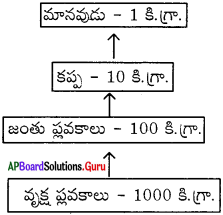
జవాబు:
ఆహారపు గొలుసులో, ప్రతి పోషకస్థాయిలో సుమారుగా 90% ఆహారం నష్టపోవడం జరుగుతుంది. 1000 కిలోల నీటిలో తేలే మొక్కలు, 100 కిలోల నీటిపై తేలే జంతు ప్లవకాల ఉత్పత్తికి అవసరమవుతుంది. ఆ 100 కిలోల జంతు ప్లవకాలు 10 కిలోల చేపల ఉత్పత్తికి, తిరిగి ఈ చేపలు ఒక కిలో మానవ కణజాలాల ఉత్పత్తికి అవసరమవుతాయి. ఈ జీవద్రవ్యరాశి ఉత్పత్తి ప్రక్రియలో, మొక్కలలో (ఉత్పత్తిదారులలో) నిక్షిప్తమైన స్థితిశక్తి (సూర్యరశ్మి ఫలితంగా) పై పోషకస్థాయులకు వెళ్ళే కొద్దీ క్రమంగా. నష్టపోవడం జరుగుతుంది.
![]()
ప్రశ్న 2.
కింద ఇవ్వబడిన సంఖ్యా పిరమిడను పరిశీలించి, ప్రశ్నలకు జవాబిమ్ము.
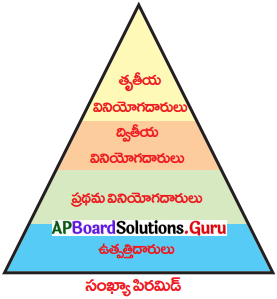
i) పోషక స్థాయిలలోని జీవుల సంఖ్య ప్రకారం అతి ఎక్కువగా, అతి తక్కువగా గల జీవులు ఏవి?
ii) ఒకవేళ ద్వితీయ వినియోగదారులు అదృశ్యమైతే ఏం జరుగుతుంది?
జవాబు:
i) పోషక స్థాయిలోని జీవుల సంఖ్య ప్రకారం ఎక్కువగా గల జీవులను ‘ఉత్పత్తిదారులు’ అని, తక్కువగా గల జీవులను ‘తృతీయ వినియోగదారులు’ అని అంటారు.
ii) ద్వితీయ వినియోగదారులు అదృశ్యమైతే తృతీయ వినియోగదారులకు ఆహారం లభించక వాటి సంఖ్య తగ్గిపోతుంది. ప్రథమ వినియోగదారుల సంఖ్య పెరుగుతుంది.
ప్రశ్న 3.
ప్రక్క పటాన్ని గమనించి క్రింది ప్రశ్నలకు సమాధానాలు రాయండి.
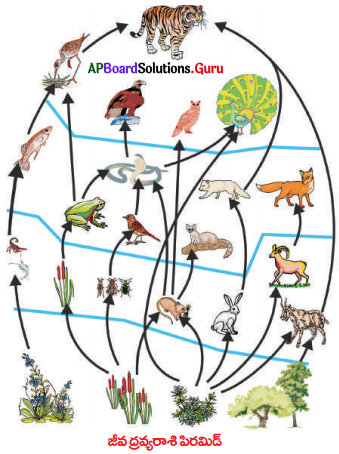
i) పై పటం నుండి ఏవైనా రెండు ఆహార గొలుసులు తెలపండి.
ii) నీవు వ్రాసిన ఆహారపు గొలుసులోని ద్వితీయ వినియోగదారులు ఏమిటి?
జవాబు:
i) a) మొక్క → మేక → పులి
b) మొక్క → కుందేలు → తోడేలు / నక్క
ii) పులి, తోడేలు / నక్క
(లేదా)
i) a) వృక్షప్లవకాలు → క్రస్టేషియన్లు → చేపలు
b) మొక్కలు → ఎలుకలు → గ్రద్ద
ii) చేపలు, గ్రద్ద
ప్రశ్న 4.
గడ్డి → మిడత → కప్ప → పాము → గద్ద
పై ఆహారపు గొలుసు నుండి కప్పను తొలగిస్తే ఏమి జరుగుతుంది? వివరించుము.
జవాబు:
- ఇవ్వబడిన ఆహారపు గొలుసులో కప్ప ద్వితీయ వినియోగదారు.
- ఈ ఆహారపు గొలుసు నుండి కప్పను తొలగించినట్లయితే మిడతల సంఖ్య పెరుగును. మరోవైపు కప్పల మీద ఆధారపడిన పాముల సంఖ్య తగ్గుతుంది.
- దీని వలన జీవావరణ సమతుల్యత దెబ్బతింటుంది.
ప్రశ్న 5.
పర్యావరణం అనగానేమి? అందలి అంశాలు ఏమిటి?
జవాబు:
పర్యావరణం :
జీవుల మీద ప్రభావం చూపే జీవ, భౌతిక కారకాలతో పాటు, రసాయన కారకాలన్నింటిలో గల పరస్పర సంబంధాన్ని “పర్యావరణం” అంటారు.
పర్యావరణంలోని అంశాలను ప్రధానంగా రెండు రకాలుగా విభజించవచ్చు. అవి:
1. నిర్జీవ అంశాలు :
గాలి, నేల, నీరు, కాంతి మొదలైన భౌతిక కారకాల ఎ “నిర్జీవ అంశాలు” అంటారు.
2. జీవకారకాలు :
మొక్కలు, జంతువులు, సూక్ష్మజీవులు, క్రిములు, కీటకాలు అన్నింటిని “జీవకారకాలు” అంటారు.
ప్రశ్న 6.
ఆహారపు గొలుసు, ఆహారజాలకాన్ని నిర్వచించండి.
జవాబు:
ఆహారపు గొలుసు :
ఆవాసంలో జీవుల మధ్య ఉండే ఆహార సంబంధాన్ని చూపించే రేఖీయ చిత్రాన్ని ఆహారపు గొలుసు అంటారు. ఇది సాధారణంగా ఉత్పత్తిదారులతో ప్రారంభమై అగ్రశ్రేణి వినియోగదారులతో ముగుస్తుంది.

ఆహారజాలం :
ఆవరణ వ్యవస్థలోని అన్ని ఆహారపు గొలుసులను కలిపి ఆహారజాలం అంటారు. ఇది సంక్లిష్ట నిర్మాణం. ఇది ఒక జీవి ఎన్ని రకాలుగా ఆహారం పొందుతుందో వివరిస్తుంది.
ప్రశ్న 7.
ఆవరణ వ్యవస్థను నిర్ణయించే కారకాలు తెలపండి.
జవాబు:
ఆవరణ వ్యవస్థలో గాలి, నీరు, నేల, ఉష్ణోగ్రత, లవణాలు, కాంతి వంటి నిర్జీవ కారకాలు ఆవరణ వ్యవస్థను నిర్ణయిస్తుంటాయి. నీటి వనరులు తక్కువగా ఉన్న ప్రాంతాలు ఎడారి ఆవాసాలుగానూ, వర్షపాతం అధికంగా ఉండే ప్రాంతాలు అటవీ ఆవాసంగానూ, జలవనరులు ఉన్న ప్రాంతాలు జల ఆవాసాలుగానూ మారతాయి.
![]()
ప్రశ్న 8.
నిచ్ అనగానేమి? ఇది ఆవాసం కంటే ఎలా భిన్నమైనది?
జవాబు:
ప్రతి జంతువు ఆహార జాలకంలో ఒక నిర్దిష్ట స్థానాన్ని కలిగి ఉంటుంది. దీనిని ఆ జంతువు యొక్క ‘ఆహార జాలకపు ఆవాసం’ లేదా ‘నిచ్’ (Niche) అని వర్ణిస్తారు. ఉదాహరణకు, ఆకుల నుండి రసాలను పీల్చే ఎఫిడ్లు అనే కీటకాలకు ఒక స్థానం ఉంటే ఆకులను చిన్నచిన్న ముక్కలుగా చేసే లేదా కొరికే దవడలున్న గొంగళి పురుగులకు మరొక స్థానం ఉంటుంది.
‘నిచ్’ అనే పదం, ఆహార జాలకంలో జంతువు యొక్క ఆక్రమించిన సరైన స్థానాన్ని మరియు ఆహారాన్నే కాకుండా, దాని జీవన విధానాన్ని తెలుపుతుంది. ఆవాసం అనేది జంతువు యొక్క నివాస స్థలమైనట్లే ‘నీచ్’ దాని బ్రతుకుదెరువును అంటే ఆ జీవి చేసే పనిని, సంచరించే ప్రదేశాలను ఆహారం పొందే విధానాన్ని మొదలైన వాటన్నింటినీ స్పష్టంగా వర్ణిస్తుంది.
ప్రశ్న 9.
ఆవరణ వ్యవస్థ పిరమిడ్లు అనగానేమి? అందలి రకాలు ఏమిటి?
జవాబు:
జీవుల మధ్య సంబంధాలను చూపడానికి లేదా వర్ణించడానికి ఆవరణ శాస్త్రవేత్తలు ‘పిరమిడ్’ (Pyramid) అనే భావనను ఉపయోగిస్తారు. వివిధ పోషక స్థాయిలలో ఆవరణ వ్యవస్థ యొక్క నిర్మాణాన్ని పిరమిడ్ రూపంలో రేఖాత్మకంగా చూపే చిత్రాన్ని ‘జీవావరణ పిరమిడ్’ (Ecological pyramid) అంటారు. బ్రిటిష్ ఆవరణ శాస్త్రవేత్త ‘చార్లెస్ ఎల్టన్’ 1927లో ఆవరణశాస్త్ర పిరమిడ్ రేఖాచిత్రాలను ప్రప్రథమంగా ప్రవేశపెట్టాడు. పిరమిడ్ పీఠభాగంలో ఉత్పత్తిదారులు (ప్రథమ పోషకస్థాయి), వాటిపై క్రమంగా ఇతర పోషకస్థాయిలు (ప్రథమ, ద్వితీయ, తృతీయ వినియోగదారులు) ఒకదానిపై ఒకటి చొప్పున పిరమిడ్ శిఖరం వరకు అమరి ఉంటాయి.
ఆవరణశాస్త్ర పిరమిడ్లు మూడు రకాలుగా ఉంటాయి. అవి: 1. సంఖ్యాపిరమిడ్లు . 2. జీవద్రవ్యరాశి పిరమిడ్లు – 3. శక్తి పిరమిడ్లు.
ప్రశ్న 10.
సంఖ్యా పిరమిడ్లు అనగానేమి? వివరించండి.
జవాబు:

ఆహారపు గొలుసులోని జీవుల సంఖ్యను పిరమిడ్ అనే రేఖాపటం ద్వారా చూపవచ్చును. పిరమిడ్ లోని ప్రతిభాగం ఆహారపు గొలుసులోని ప్రతి పోషకస్థాయి (Trophic level) లో గల జీవుల సంఖ్యను సూచిస్తుంది. ప్రథమ వినియోగదారుల స్థాయి నుండి అతిపెద్ద మాంసాహారుల వరకు, ఆహారపు గొలుసులోని ప్రతి పోషకస్థాయిలో సాధారణంగా జీవుల పరిమాణం పెరుగుతూ ఉంటుంది. కానీ జీవుల సంఖ్య తగ్గుతూ ఉంటుంది.
ప్రశ్న 11.
జీవద్రవ్యరాశి పిరమిడ్లు అనగానేమి? వివరించండి.
జవాబు:
చెట్లు, గుల్మాలు, పంటలు, గడ్డి, శైవలాలు, నీటి మొక్కలు, వ్యవసాయ మరియు అరణ్య సంబంధ అవక్షేపాలు, మొక్కల, జంతువుల విసర్జితాలన్నీ జీవద్రవ్యరాశులే. శక్తిగా మార్చడానికి వీలైన వృక్ష, జంతు సంబంధ పదార్థాన్ని జీవద్రవ్యరాశి (Biomass) అంటారు. జీవద్రవ్యరాశిని శక్తి ఉత్పత్తి కోసం వినియోగిస్తే, అది జీవశక్తి (Biofuel) అవుతుంది.
జీవద్రవ్యరాశి పిరమిడ్ ప్రతి పోషకస్థాయిలోని జీవద్రవ్యరాశి పరిమాణాన్ని, వివిధ పోషకస్థాయిలలో ఉన్న రాశుల మధ్యగల సంబంధాన్ని తెలియజేస్తుంది. భౌమ్యావరణ వ్యవస్థలలో, ఉత్పత్తిదారుల నుండి మాంసాహారుల వరకు జీవద్రవ్యరాశి క్రమంగా తగ్గుతూ ఉంటుంది. అందువల్ల జీవద్రవ్యరాశి పిరమిడ్ల నిర్మాణం నిటారుగా ఉంటుంది. జలావరణ వ్యవస్థలో ఉత్పత్తిదారుల జీవద్రవ్యరాశి ఇతర పోషక స్థాయిలలో ఉన్న జీవుల జీవద్రవ్యరాశి కంటే చాలా తక్కువగా ఉంటుంది.
ప్రశ్న 12.
జలావరణ వ్యవస్థలోని జీవద్రవ్యరాశి పిరమిడను వర్ణించండి.
జవాబు:
జలావరణ వ్యవస్థలో ఉత్పత్తిదారులైన నీటిలో తేలే మొక్కల జీవద్రవ్యరాశి, వీటిని ఆహారంగా తీసుకొనే క్రస్టేషియన్లు మరియు శాకాహార చేపల జీవద్రవ్యరాశి కన్నా చాలా తక్కువ. చిన్న చేపలు తినే పెద్ద, మాంసాహార చేపల జీవ ద్రవ్యరాశి చాలా ఎక్కువగా ఉంటుంది. అందువల్ల ఈ విధమైన పిరమిడ్ నిర్మాణం తలకిందులుగా ఉంటుంది. ఆహారపు గొలుసులోని ఒక పోషక స్థాయి నుండి తరువాత పోషక స్థాయికి 10 నుండి .20% వరకు జీవద్రవ్యరాశి బదిలీ అవుతుంది.
ప్రశ్న 13.
ఒక పోషకస్థాయిలోని జీవద్రవ్యరాశి, దాని క్రింది స్థాయిలోని జీవద్రవ్యరాశి కన్నా తక్కువగా ఉంటుంది. ఎందుకు?
జవాబు:
ఒక పోషకస్థాయిలోని జీవద్రవ్యరాశి, దాని కింది స్థాయిలోని జీవద్రవ్యరాశి కన్నా తక్కువగా ఉంటుంది. ఎందుకనగా, జీవద్రవ్యరాశి అనేది అందుబాటులో ఉన్న మొత్తం ఆహారానికి కొలమానం. జంతువులు తమ ఆహారాన్ని గ్రహించినపుడు, దానిలోని కొంతభాగం మాత్రమే తరువాత పోషకస్థాయికి ఆహారమయ్యే కొత్త కణజాలాలు ఏర్పడడానికి వినియోగించబడుతుంది. ఆహారంగా గ్రహించిన జీవద్రవ్యరాశి చాలా వరకు విసర్జింపబడడం లేదా శక్తి ఉత్పత్తిలో ఉపయోగించబడకపోవడం జరుగుతుంది.
ప్రశ్న 14.
జీవద్రవ్యరాశి పిరమిడ్లో శక్తి తగ్గుదలను వివరించండి.
జవాబు:
ఆహారపు గొలుసులో, ప్రతి పోషకస్థాయిలో సుమారుగా 90% ఆహారం నష్టపోవడం జరుగుతుంది. 1000 కిలోల నీటిలో తేలే మొక్కలు, 100 కిలోల నీటిపై తేలే జంతు ప్లవకాల ఉత్పత్తికి అవసరమవుతుంది. ఆ 100 కిలోల జంతు ప్లవకాలు 10 కిలోల చేపల ఉత్పత్తికి, తిరిగి ఈ చేపలు ఒక కిలో మానవ కణజాలాల ఉత్పత్తికి అవసరమవుతాయి. ఈ జీవద్రవ్యరాశి ఉత్పత్తి ప్రక్రియలో, మొక్కలలో (ఉత్పత్తిదారులలో) నిక్షిప్తమైన స్థితిశక్తి (సూర్యరశ్మి ఫలితంగా) పై పోషకస్థాయులకు వెళ్ళే కొద్దీ క్రమంగా నష్టపోవడం జరుగుతుంది.

ప్రశ్న 15.
కొల్లేరు సరస్సు విస్తీర్ణం తగ్గుదలకు గల కారణాలు ఏమిటి?
జవాబు:
80వ దశకం నుండి కొల్లేరు ప్రాంతంలో రొయ్యలు, చేపల పెంపకం (Acqua culture) అత్యంత లాభదాయకమైన వ్యాపారంగా విస్తరించింది. అందువల్ల అనేక మంది పెట్టుబడిదారుల దృష్టి దీని పైబడి సరస్సు ఆక్రమణలకు గురైంది. 1996 నాటికి చాలా ప్రాంతాలలో కట్టలు కట్టి నీటి ప్రవాహాన్ని మళ్ళించి సరస్సును సాగుభూమిగా మార్చారు. ఇది సరస్సు సహజ ప్రవాహ దిశను మార్చివేసింది. అందువల్ల సరస్సులో నీటి నిలువ సామర్థ్యం గణనీయంగా తగ్గిపోయింది.
ప్రశ్న 16.
విచక్షణారహితంగా పెస్టిసైడ్లు వాడటం వలన కలిగే నష్టాలు ఏమిటి?
జవాబు:
పెస్టిసైడ్లు విచక్షణారహితంగా ప్రభావాన్ని చూపుతూ, ఎక్కువ సంఖ్యలో ఇతర జంతువులను నాశనం చేస్తాయి. వీటిలో ఈ క్రిములను ఆహారంగా తీసుకొనే జంతువులు మరియు ఇతరులకు ఆహారమయ్యే జంతువులూ ఉంటాయి. ఫలితంగా పెస్టిసైడ్లు ఆహారపు గొలుసులలో అనూహ్యమైన మార్పులకు దారితీస్తూ, ఆవరణ వ్యవస్థ యొక్క సమతుల్యతను దెబ్బతీస్తాయి. ఇవి నేలలో కలిసిపోయినపుడు అవి కలిగించే ప్రభావం ఇంకా అపాయకరంగా ఉంటుంది.
ప్రశ్న 17.
జైవిక వ్యవస్థాపనం, జైవిక వృద్ధీకరణం పదాలను నిర్వచించంది.
జవాబు:
పాదరసం, ఆర్సెనిక్, సీసం కలిగియున్న పెస్టిసైడ్లు విచ్ఛిన్నం చెందవు. విచ్ఛిన్నం కాని పెస్టిసైడ్లు చాలా అపాయకరమైనవి. ఇవి ఒక్కొక్క పోషకస్థాయిలో కేంద్రీకృతమవుతూ పిరమిడ్ శిఖర భాగంలో ఉండే జంతువుల శరీరాలలోనికి చేరి అపాయకరమైన స్థాయిలో పేరుకుంటాయి. ఆహారపు గొలుసులోనికి కాలుష్యాలు చేరడాన్ని ‘జైవిక వ్యవస్థాపనం’ (Bio accumulation) అంటారు. ఆహారపు గొలుసులోని ఒక పోషకస్థాయి నుండి తరవాత పోషకస్థాయికి చేరిన కాలుష్యాలు సాంద్రీకృతమయ్యే విధానాన్ని జైవిక వృద్ధీకరణం (Bio magnification) అంటారు.
ప్రశ్న 18.
చేపలను లోహ కాలుష్య సూచికలుగా పరిగణిస్తున్నారు. ఎందుకు?
జవాబు:
పట్టణ, పారిశ్రామికీకరణ, ఆధునిక జీవన విధానాలు, మానవుల నిత్యకృత్యాల కారణంగా భారమూలకాలు దగ్గరలోని నీటివనరులలో కలుస్తున్నాయి. దీని వలన జీవజాలం ఈ కలుషిత నీటిలోనే జీవనం కొనసాగించవలసిన దుస్థితి ఏర్పడుతోంది. ఇలాంటి పరిస్థితులలో జీవించే చేపలు లోహ కాలుష్య వాతావరణానికి తీవ్రంగా ప్రతిస్పందించడాన్ని గమనించారు. అందువల్ల ఈ మధ్యకాలంలో చేపలను లోహకాలుష్యాలకు జీవసూచికలుగా భావిస్తున్నారు.
![]()
ప్రశ్న 19.
ఏదులాబాదు రిజర్వాయర్ లోని చేపలలో గుర్తించిన కలుషితాలు ఏమిటి?
జవాబు:
ఏదులాబాదు చేపల్లో భారమూలకాల పరిమాణం దేశ సగటు కన్నా ఎక్కువగా ఉన్నట్లు తెలిసింది. అలాగే భారమూలకాల సంచయనాన్ని పరిశీలిస్తే అన్నింటికన్నా ఎక్కువ ఇనుము ఉండగా సీసం, క్రోమియం, నికెల్, కాడ్మియం తరువాతి స్థానాల్లో ఉన్నాయి. ఈ మూలకాలు ఆహార జాలకం ద్వారా చేపల కణాల్లో చేరి అక్కడ నుండి మానవులలోకి చేరుతున్నాయి. చేపల కాలేయం, మొప్పలు, మూత్రపిండాలలో కాడ్మియం అత్యధికంగా చేరుతోంది. అతి తక్కువ గాఢతలలో కూడా చేపలు కాడ్మియం లోహానికి సున్నితత్వాన్ని కలిగి ఉండడం వల్ల ఇది చేపల కణజాలంలోకి సులభంగా చేరుతోందని గుర్తించారు. క్రోమియం, ఇనుము, నికెల్, సీసం తరువాతి స్థానాలలో ఉన్నాయి.
ప్రశ్న 20.
మానవ కార్యకలాపాలు సహజ ఆవరణవ్యవస్థలపై ఎలాంటి ప్రభావాన్ని చూపుతాయి?
జవాబు:
నదులపై ఆనకట్టలు నిర్మిస్తూ, చిత్తడి నేలలను, సముద్రతీరాలను ఆక్రమిస్తూ, అడవులను నరుకుతూ, భూమిని దున్ని పంటలను పండిస్తూ, కాలువలు, రహదారులు, పట్టణాలు మరియు నగరాలను నిర్మిస్తూ మానవుడు సహజ ఆవరణ వ్యవస్థలను ఎన్నో మార్పులకు గురిచేశాడు. ఈ మార్పులు సహజ ఆవరణ వ్యవస్థలలో నివసిస్తున్న వృక్ష, జంతుసముదాయాలను చాలా వరకు మార్చివేశాయి.
ప్రశ్న 21.
ఒక పట్టణ అభివృద్ధిలో ఏ ఏ మార్పులు, జీవజాలంలో చోటు చేసుకుంటాయి?
జవాబు:
- కొన్ని వృక్షజంతు జాతులు చనిపోతాయి.
- కొన్ని మారిన, కొత్త పరిస్థితులకు అనుకూలంగా మార్చుకొని తక్కువ సంఖ్యలో మనుగడ కొనసాగిస్తాయి.
- కొన్ని మారిన, కొత్త పరిస్థితుల నుండి లాభాన్ని పొందుతూ, వాటి సంఖ్యను పెంచుకుంటాయి.
ప్రశ్న 22.
మినిమేటా వ్యాధి గురించి రాయండి.
జవాబు:
మినిమేటా వ్యాధిని మొదట 1956వ సంవత్సరంలో జపాన్లోని కుమయోటో ప్రిఫెక్చర్ లో గల మిమిమేటా నగరంలో కనుగొన్నారు. 1932 నుండి 1968 వరకు చిస్సో కార్పొరేషన్ వారి రసాయన పరిశ్రమ నుండి విడుదలైన మిథైల్ మెర్క్యురీతో కూడిన వ్యర్థజలాలే మినిమేటా వ్యాధికి కారణం. షిరని సముద్ర (Shiranui sea), మినమేటా అఖాతంలో ఉండే చేపల ద్వారా వీటిని తినే స్థానిక మనుషుల్లోకి మిథైల్ మెర్క్యురీ చేరి అనారోగ్యాలకు దారితీసింది. ఫలితంగా పిల్లులు, కుక్కలు, పందులు, మనుషుల మరణాలు 36 ఏళ్లపాటు కొనసాగాయి.
ప్రశ్న 23.
పిచ్చుకల ప్రయోజనాన్ని శాస్త్రవేత్తలు ఎలా తెలియజేశారు?
జవాబు:
చనిపోయిన పిచ్చుకల జీర్ణవ్యవస్థలోని పదార్థాలను శాస్త్రవేత్తలు పరిశీలించారు. దానిలో మూడు వంతులు పంటలను నాశనం చేసే క్రిమికీటకాలు ఉండగా, ఒక వంతు మాత్రమే ధాన్యపు గింజలు ఉన్నట్లు కనుగొన్నారు. పిచ్చుకలు మానవులకు ఎంతో ఉపయోగం కలిగించే పక్షులని వారు తమ పరిశోధనల ద్వారా నిర్ధారణకు వచ్చారు. పిచ్చుకలను నాశనం చేసే ప్రయత్నాల వలన పంట దిగుబడి పెరగకపోగా మరింతగా తగ్గిపోయింది.
ప్రశ్న 24.
పిచ్చుకల నిర్మూలన వలన కలిగే నష్టాలు ఏమిటి?
జవాబు:
మిడతలను తినే పిచ్చుకలు లేకపోవడంతో పంటలపై మిడతల దాడి ఎక్కువయింది. దానితో పాటు ప్రతికూల వాతావరణ పరిస్థితులు కూడా తోడయ్యాయి. అతి పెద్ద కరవుకు దారితీశాయి. మిడతలను చంపడానికి కీటకనాశనులను పెద్దమొత్తంలో వినియోగించడం ప్రారంభించడంతో నేల నాణ్యత క్షీణించిపోయింది. పొలాలలో పనిచేయాల్సిన రైతులు వ్యవసాయం గిట్టుబాటు కాకపోడంతో వేల సంఖ్యలో గ్రామాలను వదిలి పరిశ్రమలలో కార్మికులుగా పనిచేయడానికి వలస వెళ్ళారు.
![]()
ప్రశ్న 25.
కొల్లేరు సరస్సు నీటి నిలువ సామర్థ్యం తగ్గటానికి కారణాలు ఏమిటి?
జవాబు:
- కొల్లేరు సరస్సు అధికంగా ఆక్రమణలకు లోనైంది.
- పరిసరప్రాంతాలను వ్యవసాయ భూములుగా మార్చారు.
- చేపల పరిశ్రమ లాభసాటిగా ఉండుటవలన ఆక్రమిక ప్రాంతాలు రొయ్యల సాగు కేంద్రాలుగా మారాయి.
- కలుషితాలు చేరి, పూడిక పెరిగింది. 5. ఆక్రమణల వలన నీటి ప్రవాహదిశ మారి, నీటి నిల్వ సామర్థ్యం తగ్గింది.
10th Class Biology 9th lesson మన పర్యావరణం – మన బాధ్యత 4 Marks Important Questions and Answers
ప్రశ్న 1.
క్రిమి కీటకాల బారి నుండి పంటలను, ఆహార పదార్థాలను నివారించే క్రిమి సంహారకాలను ఉపయోగించాలా? లేదా ప్రత్యామ్నాయాలను ఆలోచించాలా ? ఆ విషయం గురించి మీ అభిప్రాయాన్ని, దానికి గల కారణాలను రాయండి.
జవాబు:
- క్రిమి సంహారకాలను ఉపయోగించరాదు. వీనికి ప్రత్యామ్నాయ విధానాలను అనుసరించాలి.
- విచక్షణ కాని క్రిమి సంహారకాల వినియోగం వివిధ రకాల కాలుష్యాలకు కారణమవుతుంది.
- హానికారక క్రిమిసంహారకాలు ఆవరణ వ్యవస్థలోనికి చేరి జైవిక వ్యవస్థాపనం, జైవిక వృద్ధీకరణంలకు కారణమైన పర్యావరణ సమతుల్యతను దెబ్బతీస్తున్నది.
- క్రిమిసంహారకాలకు ప్రత్యామ్నాయంగా జైవిక నియంత్రణ, వంధ్యత్వం, జన్యు ఉత్పరివర్తన రకాల అభివృద్ధి మరియు తెగుళ్ళకు సంబంధించిన మూలకారణాల అన్వేషణ విధానాలను అనుసరించాలి.
ప్రశ్న 2.
క్రిమి సంహారకాల వినియోగాన్ని ఆపివేసి నేల కాలుష్యం నివారించడానికి అనువైన ఏవైనా 4 పర్యావరణహిత పద్ధతులను వివరించండి.
(లేదా)
పంటలకు హాని కలిగించే చీడ పీడలను నివారించేందుకు అనుసరించాల్సిన ఏవేని నాలుగు జైవిక నియమాలను రాయండి.
జవాబు:
పంటలను నాశనం చేసే చీడలను తొలగించడానికి వాడే, రసాయనిక క్రిమి సంహారకాల పర్యావరణాన్ని నాశనం చేయడమే కాక నేలను కూడా కాలుష్యం చేస్తాయి. నేల కాలుష్యాన్ని నివారించడానికి ఈ క్రింది పద్ధతులు ఆచరణ యోగ్యం అయినవి.
1) పంట మార్పిడి :
ప్రతి సంవత్సరం ఒకే పంటను కాకుండా వేరు వేరు పంటలను పండించే పంట మార్పిడి విధానాన్ని పాటించడం వల్ల తెగుళ్ళను, వాటి వల్ల కలిగే నష్టాన్ని నివారించవచ్చు.
2) తెగుళ్ళకు సంబంధించిన పూర్వాపరాలను తెలుసుకోవడం :
ఏ తెగులు ఎలా వ్యాపిస్తుంది, దీనికి మూల కారణాలేంటి, అనే విషయాలను పూర్తిగా అర్ధం చేసుకోవడం వలన పంట నష్టాన్ని నివారించవచ్చు.
3) జైవిక నియంత్రణ :
తెగుళ్ళు కలిగించే కారకాలను తినే పరాన్న జీవులను, నిశాచర మాంస భక్షకులను ప్రవేశపెట్టడం ద్వారా తెగుళ్ళను నివారించవచ్చు.
4) వంధ్యత్వం :
తెగుళ్ళు కలిగించే క్రిమి కీటకాల పురుష జీవుల పునరుత్పత్తి సామర్థ్యం కోల్పోయేలా వంధ్యత్వం చేయడం ద్వారా వాటి వ్యాప్తిని అరికట్టవచ్చు.
5) జన్యు ఉత్పరివర్తన రకాలు :
వివిధ రకాల తెగుళ్ళను, వాతావరణ పరిస్థితులను తట్టుకునే జన్యు సంబంధ రకాలను అభివృద్ధి చేయడం ద్వారా పురుగుమందుల వినియోగాన్ని తగ్గించవచ్చు.
6) పర్యావరణ నైతికత కల్గి ఉండడం :
పర్యావరణం పట్ల నైతికత కల్గి ఉండాలి. పర్యావరణ సంబంధ చట్టాలను తెలుసుకోవడమే కాక పర్యావరణపరంగా ఏది సరి అయినది ఏది సరికానిదో తెలుసుకొని ప్రవర్తించాలి.
ప్రశ్న 3.
ఈ దిగువనీయబడిన పటములోని సమాచారాన్ని విశ్లేషించి ఇచ్చిన ప్రశ్నలకు సమాధానం వ్రాయుము.

i) మీకివ్వబడిన ఆహార జాలకంలో ప్రాథమిక ఉత్పత్తిదారులు ఏవి?
ii) పటము నుండి ఏదైనా ఒక ఆహారపు గొలుసును తయారు చేయండి.
iii) పై ఆహారజాలకంలో తృతీయ వినియోగదారులేవి?
iv) ఏవేని రెండు శాకాహార జంతువుల పేర్లను తెలపండి.
జవాబు:
i) మొక్కలు, గడ్డి, వృక్షప్లవకాలు, చెట్లు మొదలైనవి.
ii) గడ్డి → కుందేలు → నక్క → పులి
iii) పులి, రాబందు, కొంగ, గుడ్లగూబ, నెమలి మొదలైనవి.
iv) కుందేలు, జింక, మేక, ఆవు
![]()
ప్రశ్న 4.
ప్రక్కన చూపిన జీవ ద్రవ్యరాశి పిరమిడ్ ను పరిశీలించి, ప్రశ్నలకు సమాధానాలు వ్రాయుము.
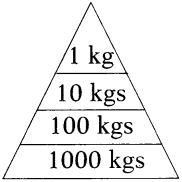
a) ఈ పిరమిడ్ లో పైకి వెళ్ళే కొద్దీ ద్రవ్యరాశి తగ్గిపోతుంది కదా ! ఎందుకు?
జవాబు:
ఈ పిరమిడ్ నందు ఉత్పత్తిదారుల నుండి పై పోషకస్థాయికి పోయేకొలది జీవ ద్రవ్యరాశి 10% మాత్రమే బదిలి జరుగుతుంది. అందువలన ద్రవ్యరాశి తగ్గిపోతుంది.
b) ఉత్పత్తిదారులకు, ప్రాథమిక వినియోగదారులకు కొన్ని ఉదాహరణలిమ్ము..
జవాబు:
ఉత్పత్తిదారులు : ఆకుపచ్చని మొక్కలు, శైవలాలు, వృక్ష ప్లవకాలు
ప్రాథమిక వినియోగదారులు : శాకాహార జంతువులు (లేదా) కుందేలు, ఆవు, మేక మొ॥
c) ఉత్పత్తిదారులకు శక్తి ఎక్కడి నుండి లభిస్తుంది?
జవాబు:
ఉత్పత్తిదారులకు శక్తి సూర్యుని నుండి లేదా సూర్యరశ్మి నుండి లభిస్తుంది.
d) ప్రతీ పోషకస్థాయిలో ఎంత ద్రవ్యరాశి నష్టపోతున్నది?
జవాబు:
ప్రతీ పోషకస్థాయిలో 90% ద్రవ్యరాశి నష్టపోతుంది.
ప్రశ్న 5.
శక్తి పిరమిడ్ ను వివరించండి.
జవాబు:

- ఆవరణ వ్యవస్థలో ఆహారం ద్వారా జీవులలో శక్తి ప్రసరణ జరుగుతుంది. ఆహారపు గొలుసులో కేలరీలు శక్తిప్రసరణను పిరమిడ్ ఆకారంలో రేఖాత్మకంగా సూచించడాన్ని “శక్తి పిరమిడ్” అంటారు.
- ఆహారగొలుసులో ప్రతి స్థాయి వద్ద శక్తి నష్టం జరుగుతుంది. ప్రతి పోషక స్తాయిలో 20% ఆహారం నష్టపోవడం జరుగుతుంది.
- కావున ఆహారపు గొలుసులో పైకి ప్రయాణిస్తున్నది కొలది శక్తి విలువ తగ్గుతుంది, అందువలన శక్తిపిరమిడ్ ఎల్లప్పుడూ శీర్షాభిముఖంగానే ఉంటుంది.
- ఈ పిరమిడ్ లో అడుగుభాగాన ఉత్పత్తిదారులు అధిక శక్తిని కలిగి ఉండగా, ప్రతి పోషక స్థాయిలో సుమారు 10% శక్తి బదిలీ అవుతూ ఉంటుంది.
ప్రశ్న 6.
నీటిలో అధిక పోషకాలు కలిగిన వ్యర్థాలు చేరటం వలన కలిగే నష్టాలు ఏమిటి?
జవాబు:
వ్యవసాయ రసాయనాలు, ఎరువులు, చేపల చెరువుల వ్యర్థాలు, పరిశ్రమల నుండి వెలువడే వ్యర్థ రసాయనాలు, మున్సిపల్ వ్యర్థాలు మొదలైనవన్నీ సరస్సులో కలిసి కాలుష్యాన్ని కలిగిస్తున్నాయి. ఎక్కువ పోషకాలు కలిగిన వ్యర్థాలు (Anthropogenic pollutants) కలుపు విపరీతంగా పెరగడానికి కారణమవుతున్నాయి.
ఫలితంగా సరస్సులో నీరు క్షారస్వభావంతో, మురికిగా, పోషక పదార్థాలతో కూడి ఉండడం వల్ల నీటిలో కరిగే ఆక్సిజన్ పరిమాణం (DO) తగ్గిపోయింది. జైవిక ఆక్సిజన్ డిమాండ్ (BOD) ఎక్కువ కావడం వలన జలచరాలపై తీవ్ర ప్రభావం కలిగింది. ఇక్కడి ప్రజలకు జలకాలుష్యంపై అవగాహన లేకపోవడం వల్ల డయేరియా, కలరా, టైఫాయిడ్, అమీబియాసిస్ మొదలైన నీటి ద్వారా వ్యాపించే వ్యాధులు తీవ్రంగా వ్యాప్తి చెందాయి. వీటితో పాటు దోమలు వంటి వాహకాల ద్వారా వ్యాప్తి చెందే వ్యాధులు కూడా ప్రబలాయి. రొయ్యలు, చేప వంటి జలచరాలు కూడా కాలుష్యానికి గురయ్యాయి. పొలాలు వ్యవసాయానికి యోగ్యం కాకుండా పోయాయి. దిగుబడి తగ్గిపోయింది.
ప్రశ్న 7.
చైనా ప్రభుత్వం పిచ్చుకలను చంపే కార్యక్రమం ఎందుకు చేపట్టింది?
జవాబు:
చైనా ప్రభుత్వం పారిశ్రామిక ఉత్పత్తులను పెంచే దిశలో గ్రామీణ రైతులను పెద్ద ఎత్తున ప్రోత్సహించింది. పారిశ్రామిక ఉతృతిని త్వరితంగా సాధించడానికి ఎన్నో ప్రణాళికలు రూపొందించారు. అభివృద్ధి చెందిన దేశాల మాదిరిగా తొందరగా ఆధునికతను రూపుదిద్దుకొనేందుకు చైనా ప్రభుత్వం ఉద్యమాన్ని చేపట్టింది. అయితే అప్పటిదాకా చైనా వ్యవయసాయాధారిత సమాజమే. ఈ ఉద్యమంలో భాగంగా 5000 కుటుంబాలతో సమూహాలుగా ఏర్పడి వ్యవసాయం చేయడం అన్నది ఒక ముఖ్యాంశం. దీనివల్ల పంట దిగుబడి రెట్టింపు అయ్యింది.
ఈ మొదటి విజయంతో తరువాతి సంవత్సరానికి మరింత పెద్ద లక్ష్యాలను రూపొందించుకోవడం జరిగింది. కానీ వాతావరణం అందుకు సహకరించలేదు. కొంత పంట దిగుబడి వచ్చినప్పటికీ తగిన ఫలితాలను సాధించలేకపోయామనే భయంతో ప్రభుత్వ వ్యవసాయాధికారులు దిగుబడిని ఎక్కువగా లెక్కగట్టారు. ఈ తప్పుడు లెక్కలు ప్రజల అవసరాలకు ఆహార సరఫరాలకు మధ్యగల సమతుల్యత పై తీవ్రంగా ప్రభావం చూపాయి. దీనినుండి తప్పించుకోవడానికి అధికారులు తమ తప్పిదాన్ని పిచ్చుకలపైకి నెట్టారు. గిడ్డంగుల నుండి సంవత్సర కాలంలో ఒక పిచ్చుక సుమారుగా 1.8 కిలోల ధాన్యపు గింజలు తిన్నదని అందువల్ల ఆహార కొరత ఏర్పడిందని ప్రకటించారు. పిచ్చుకలపై నేరాన్ని మోపారు. పల్లెల్లో, పట్టణాల్లో ప్రజలందరినీ పిచ్చుకలపై యుద్ధం చేయాల్సిందిగా ఆదేశించారు.
ప్రశ్న 8.
మీ ఇంట్లో ఏయే పనులకు శిలాజ ఇంధనాలను ఉపయోగిస్తున్నారు? వాటిని సంరక్షించడానికి నీవు చేపట్టే చర్యలు ఏవి?
జవాబు:
మా ఇంట్లో LPGని వంటకు, వేడి చేయడానికి మరియు మండించే ప్రక్రియలందు శిలాజ ఇంధనాలను వినియోగిస్తాము. పెట్రోలు మరియు డీజిలను రవాణాకు మరియు జనరేటర్లు, నీటిపంపులు పనిచేయడానికి వినియోగిస్తాము.
శిలాజ ఇంధనాలను సంరక్షించడానికి చేపట్టే చర్యలు :
- వంట చేయడానికి అవసరమయిన పదార్ధములు మరియు పాత్రలు సిద్ధం చేసుకున్న తర్వాతే వంట చేయడం మొదలు పెడతాను.
- అన్నంను రైస్ కుక్కర్ నందు వండుట వలన 20% మరియు మాంసంను వండుట ద్వారా 41.5% సహజ వాయువును ఆదా అయ్యే విధంగా చూస్తాను.
- ప్రెజర్ కుక్కర్ నందు మరిగే ప్రక్రియ – ప్రారంభం అయిన వెంటనే పొయ్యి మంట పరిమాణాన్ని తగ్గిస్తాను. దీని ద్వారా నాకు 35% ఇంధనం ఆదా అవుతుంది.
- ఆహార పదార్థాలను వండడానికి ముందు కొంచెం సేపు నానబెట్టుట వలన 22% ఇంధనం ఆదా చేయగలుగుతాను.
- వెడల్పు మరియు తక్కువ లోతుగల పాత్రలలో ఆహార పదార్థాలను వండుతాను. తద్వారా ఇంధనమును ఆదా చేస్తాను.
- వండే పాత్రలపై మూతను ఉంచుట ద్వారా ఆహార పదార్ధములు త్వరగా ఉడుకునట్లు చూస్తాను.
- పాఠశాలకు నడకద్వారా ప్రతిరోజు వచ్చి వెళతాను. దూర ప్రాంతాలకు వెళ్ళటానికి ప్రభుత్వ రవాణా సాధనములను ఉపయోగిస్తాను.
- శిలాజ ఇంధనాలకు బదులుగా నీటిని వేడిచేయడానికి, బల్బులను వెలిగించడానికి సోలార్ శక్తిని వినియోగిస్తాను.
- పెట్రోలు మరియు డీజిల్ తో నడిచే జనరేటర్లు, నీటి పంపులను సోలార్ పవర్ తో నడిచే విధంగా చూస్తాను.
ప్రశ్న 9.
సాధారణంగా ఆవరణ వ్యవస్థలలో ఉత్పత్తిదారుల నుండి అగ్రభాగాన ఉండే మాంసాహారులకు చేరేసరికి జీవుల సంఖ్య, జీవద్రవ్యరాశి తగ్గడానికి గల కారణాలు ఏమిటి?
జవాబు:
ఆహారపు గొలుసులో స్థాయి పెరిగే కొలది శక్తి ప్రసరణ తగ్గుతుంది. సరిపడిన శక్తి కొరకు వినియోగదారులు అధిక సంఖ్యలో వాటి కింది జీవులను ఆహారంగా తీసుకోవలసి ఉంటుంది. అందువలన ఆహార కొరత ఏర్పడి, అగ్రశ్రేణి మాంసాహారుల సంఖ్య తక్కువగా ఉంటుంది. కావున ఆహారపు గొలుసులో ఉత్పత్తిదారుల కంటే వినియోగదారుల సంఖ్య తక్కువగా ఉంటుంది.
ఆహారపు గొలుసులో ప్రతి పోషక స్థాయిలో సుమారుగా 90% ఆహారం నష్టపోవడం జరుగుతుంది. జంతువులు తమ ఆహారాన్ని గ్రహించినపుడు దానిలోని కొంత భాగం మాత్రమే తరువాత పోషకస్థాయికి అవసరమయ్యే కొత్త కణజాలాలు ఏర్పడడానికి వినియోగించబడుతుంది. ఆహారంగా గ్రహించిన జీవద్రవ్యరాశి చాలా వరకు విసర్జింపబడటం లేదా శక్తి ఉత్పత్తిలో ఉపయోగించకపోవడం జరుగుతుంది. జీవద్రవ్యరాశి ఉత్పత్తి ప్రక్రియలో, మొక్కలలో నిక్షిప్తమైన . స్థితిశక్తి పై పోషకస్థాయిలకు వెళ్ళే కొద్దీ క్రమంగా నష్టపోవడం జరుగుతుంది.
![]()
ప్రశ్న 10.
మీ గ్రామములో కుటుంబ నియంత్రణ, ఆరోగ్య పరిశుభ్రత, పచ్చదనం, పోలియో, ఎయిడ్స్ వంటి కార్యక్రమాలు అమలుపరచడానికి ఎప్పుడు, ఏయే సందర్భాలలో, ఎటువంటి కార్యక్రమాలు చేపడతావో పట్టిక రూపంలో రాయండి.
జవాబు:
| వ్యాధి పేరు/ కార్యక్రమం పేరు | అమలు పరిచే కార్యక్రమాలు |
| 1. పోలియో | పల్స్ పోలియో కార్యక్రమము నందు అందరు పిల్లలకు వ్యాక్సిన్ వేయటం. ఇంటింటి ప్రచారం – పోలియో రహిత సమాజం కోసం ప్రచారం. కరపత్రముల ద్వారా పోలియో వ్యాధి నివారణ చర్యలు ప్రచారం చేయటం. డాక్టర్లచే అవగాహన కార్యక్రమాలు ఏర్పాటు చేయడం |
| 2. AIDS | ఆశ వర్కర్ల సహాయంతో HIV వైరస్ పట్ల ఇంటింటికి తిరిగి అవగాహన కల్గించడం. ఎయిడ్స్ వ్యాధిగ్రస్తులచే ప్రచారం చేయించటం కరపత్రాలు మరియు గోడపత్రికలు విడుదల చేయడం. ప్రపంచ ఎయిడ్స్ దినోత్సవం (డిసెంబర్ 1) జరపటం సామూహిక ఆరోగ్య పరీక్షలను నిర్వహించడం నిపుణులైన వైద్యులచే సమావేశాలు నిర్వహించడం |
| 3. కుటుంబ నియంత్రణ | ప్రజలలో అవగాహన కల్పించడం సామూహిక కుటుంబ నియంత్రణ శస్త్రచికిత్సా శిబిరాలను ఏర్పాటు చేయడం. |
| 4. ఆరోగ్యం – పరిశుభ్రత | ఆరోగ్యంగా ఉండవలసిన అవసరంపై ప్రజలకు అవగాహన కల్పించుట. పరిశుభ్రత పై నిపుణులచే సలహాలు ఇప్పించుట ఆరోగ్య పరీక్షా శిబిరాలు నిర్వహించడం ప్రపంచ ఆరోగ్య దినోత్సవం కార్యక్రమాల నిర్వహణ |
| 5. పచ్చదనం | పచ్చదనం పట్ల ప్రజలకు అవగాహన కల్పించడం సామూహిక చెట్లు నాటే కార్యక్రమాలు వనమహోత్సవాల నిర్వహణ |
ప్రశ్న 11.
పర్యావరణ స్నేహపూర్వక కృత్యాలు మీ పాఠశాలలో ఏమేమి నిర్వహిస్తారో రాయండి.
జవాబు:
- పర్యావరణ క్లబ్బులను పాఠశాలలో ఏర్పడే విధంగా చూస్తాము. క్లబ్బు సభ్యులు పర్యావరణ పరిరక్షణ కార్యక్రమాలు నిర్వహించడం వాటిలో గ్రామ ప్రజల భాగస్వామ్యము ఉండే విధంగా చూస్తాము.
- పాఠశాల యందు అందమైన తోటను ఏర్పాటు చేయడానికి కృషి చేస్తాము. ఇందులో పూల, పండ్ల మరియు కూరగాయల మొక్కలు ఉండే విధంగా చూస్తాము.
- పాఠశాలలో ప్రతిరోజు మధ్యాహ్నం మూడు గంటలకు కరెంటు సరఫరాను నిలుపుదల చేయు అలవాటును విద్యార్థులలో కల్పిస్తాను. దీనిద్వారా విద్యుత్తును ఆదా చేయవచ్చు.
- పాఠశాలలో పోగయిన చెత్తను కాల్చకుండా చూస్తాము. క్రుళ్ళిపోయే పదార్థాలను గుర్తించి వాటిని కంపోస్టు ఎరువు తయారీలో వినియోగిస్తాము. పాఠశాల ఆవరణ పరిశుభ్రంగా, స్వచ్ఛంగా ఉండేలా చూస్తాము.
- పాఠశాల ఒక మూలయందు కంపోస్టు ఎరువును తయారు చేయుటకు గుంటను త్రవ్వి అందులో మధ్యాహ్న భోజన సమయంలో తయారగు వ్యర్థాలు అన్నింటిని వేసి కంపోస్టు తయారీని చేపడతాము. దానిని పాఠశాలలో పెరిగే మొక్కలకు ఎరువుగా వినియోగిస్తాం.
- బాల బాలికలు పాలిథీన్ కవర్లు కాకుండా గుడ్డ సంచులను వినియోగించే విధంగా ప్రోత్సహిస్తాము.
- ఘన వ్యర్థాలను సేకరించి వాటిని సక్రమ నిర్వహణ ద్వారా వినియోగించి నేల కాలుష్యము కాకుండా చూస్తాము.
- విద్యార్థిని విద్యార్థులు ‘4R’ ల పద్ధతిని పాటించే విధంగా కృషి చేస్తాము. తగ్గించడం, తిరిగి వినియోగించడం మరియు పునఃచక్రీయం పద్ధతులను అవలంబించే విధంగా కృషి చేస్తాము.
ప్రశ్న 12.
జీవ ద్రవ్యరాశి అనగానేమి? కింద ఇవ్వబడిన ఆహారపు గొలుసును ఉదాహరణగా తీసుకొని, జీవద్రవ్యరాశి పిరమిడు గీయండి.
ఎ) గడ్డి బి) శాకాహారులు సి) మాంసాహారులు డి) గద్ద లేదా రాబందు
జవాబు:
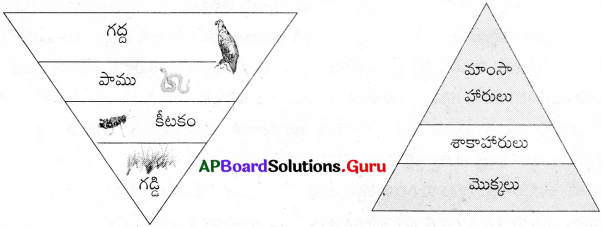
శక్తిగా మార్చటానికి వీలైన వృక్ష, జంతు సంబంధ పదార్థాన్ని జీవద్రవ్యరాశి అంటారు. వివిధ ఆహారపు గొలుసుల జీవ ద్రవ్యరాశి పిరమిడ్లను నిర్మిస్తే అవి ఆహారపు గొలుసులోని జీవుల పరిమాణాన్ని సూచిస్తాయి.
గడ్డి → కీటకం → పాము → గద్ద
ఉత్పత్తి శాకాహారి → మాంసాహారి → అగ్రశ్రేణి మాంసాహారి
పై ఆహారపు గొలుసు యొక్క జీవద్రవ్యరాశి పిరమిడను నిర్మిస్తే అది అధోముఖంగా ఉంటుంది. ఈ ఆహారపు గొలుసులో పైకి వెళ్ళేకొలది జీవుల యొక్క జీవ ద్రవ్యరాశి పెరుగుతుండుట వలన పిరమిడ్ తలక్రిందులుగా ఏర్పడింది. కానీ సాధారణంగా భౌమ ఆవరణ వ్యవస్థలో జీవద్రవ్యరాశి పిరమిడ్లు శీర్షాభిముఖంగా ఉంటాయి.
10th Class Biology 9th lesson మన పర్యావరణం – మన బాధ్యత ½ Mark Important Questions and Answers
విస్తరింపుము
1. EBWRని విస్తరించండి.
జవాబు:
ఎడులాబాద్ వాటర్ రిజర్వాయర్
2. MOEF ని విస్తరించండి.
జవాబు:
పర్యావరణ మరియు అటవీ మంత్రిత్వ శాఖ
3. BODని విస్తరించండి.
జవాబు:
బయోలాజికల్ ఆక్సిజన్ డిమాండ్
4. DO ని విస్తరించండి.
జవాబు:
కరిగిన ఆక్సిజన్
దోషాన్ని గుర్తించి, సరిచేసి వ్రాయండి
5. పర్యావరణ వ్యవస్థలోని జీవులను, భాగాలను జీవేతర కారకాలు అంటారు.
జవాబు:
పర్యావరణ వ్యవస్థలోని జీవులను, భాగాలను జీవ కారకాలు అంటారు.
6. జీవ కారకాలను పర్యావరణ కారకాలు అని కూడా అంటారు.
జవాబు:
నిర్జీవ కారకాలను పర్యావరణ కారకాలు అని కూడా అంటారు.
7. పర్యావరణ వ్యవస్థలో వినియోగదారులు క్షీణిస్తున్న సేంద్రియ పదార్థాన్ని తిని, వివిధ అణువులుగా తిరిగి పర్యావరణానికి మారుస్తారు.
జవాబు:
పర్యావరణ వ్యవస్థలో విచ్ఛిన్నకారులు క్షీణిస్తున్న సేంద్రియ పదార్థాన్ని తిని, వివిధ అణువులుగా తిరిగి పర్యావరణానికి మారుస్తారు.
![]()
8. పోషకస్థాయి ఆహారజాలకంలో జంతువుల స్థానాన్ని మరియు దాని జీవన విధానాన్ని సూచిస్తుంది.
జవాబు:
నిచ్ ఆహారజాలకంలో జంతువుల స్థానాన్ని మరియు దాని జీవన విధానాన్ని సూచిస్తుంది.
9. ఈజిప్ట్ పిరమిడ్ అనేది ఆహార గొలుసులోని వివిధ పోషక స్థాయిల జీవుల మధ్య సంబంధాల యొక్క గ్రాఫికల్ ప్రాతినిధ్యం.
జవాబు:
పర్యావరణ పిరమిడ్ అనేది ఆహార గొలుసులోని వివిధ పోషక స్థాయిల జీవుల మధ్య సంబంధాల యొక్క గ్రాఫికల్ ప్రాతినిధ్యం.
10. పర్యావరణ పిరమిడ్ యొక్క అడుగు ఎల్లప్పుడూ విచ్ఛిన్నకారుల చేత ఆక్రమించబడుతుంది.
జవాబు:
పర్యావరణ పిరమిడ్ యొక్క అడుగు ఎల్లప్పుడూ ఉత్పత్తిదారుల చేత ఆక్రమించబడుతుంది.
11. ఆహార గొలుసులో ప్రతి దశలో సుమారు 10% ఆహారం పోతుంది.
జవాబు:
ఆహారగొలుసులో ప్రతి దశలో సుమారు 90% ఆహారం పోతుంది.
12. ఆహార గొలుసులోకి కాలుష్య కారకాలను ప్రవేశపెట్టే ప్రక్రియను బయో మాగ్నిఫికేషన్ అంటారు.
జవాబు:
ఆహార గొలుసులోకి కాలుష్య కారకాలను ప్రవేశ పెట్టే ప్రక్రియను జైవీకరణ అంటారు.
13. కాలుష్య కారకాలు ఒక పోషకస్థాయి నుండి తదుపరి పోషకస్థాయికి వెళ్ళేటప్పుడు కేంద్రీకృతమయ్యే ధోరణిని జైవీకరణ అంటారు.
జవాబు:
కాలుష్య కారకాలు ఒక పోషకస్థాయి నుండి తదుపరి పోషక స్థాయికి వెళ్ళేటప్పుడు కేంద్రీకృతమయ్యే ధోరణిని జైవిక వృద్ధీకరణ అంటారు.
నేను ఎవరు?
14. నేను ఒక వ్యా ధిని. నేను మొట్టమొదట 1956లో జపాన్లో కనుగొనబడ్డాను. నా కారణంగా పిల్లి, కుక్క పంది మరియు మానవుల మరణాలు 36 ఏళ్ళు కొనసాగాయి. నేను ఎవరు?
జవాబు:
మినిమేటా
15. నేను ఆంధ్రప్రదేశ్ లో ఉన్న మంచినీటి సరస్సును. నేను 20 మిలియన్ల నివాసితులకు ఆవాసంగా ఉన్నాను. 1999లో ఆంధ్రప్రదేశ్ ప్రభుత్వం నన్ను పక్షుల అభయారణ్యంగా ప్రకటించింది.
జవాబు:
కొల్లేరు సరస్సు
16. నేను బ్రిటిష్ పర్యావరణవేత్తను. పర్యావరణ పిరమిడ్ అనే పదాన్ని పరిచయం చేసిన మొదటి వ్యక్తిని నేను.
జవాబు:
చార్లెస్ ఎల్టన్
17. ఆహార గొలుసు మరియు ఆహార జాలకం గురించి తప్పుగా పేర్కొన్న వ్యత్యాసాన్ని కనుగొనండి.
1. ఇది జీవుల యొక్క సరళ ప్రముల.
2. ఇది బహుళ ఆహార గొలుసుల సముదాయం
3. ఆహార గొలుసు బహుళమార్గాన్ని అనుసరిస్తుంది.
4. ఆహార జాలకం ఒకే మార్గాన్ని అనుసరిస్తుంది.
జవాబు:
4 – ఆహార జాలకం ఒకే మార్గాన్ని అనుసరిస్తుంది.
జతపరచుట
18. సరిగ్గా సరిపోలిన దాన్ని గుర్తించండి.
సంఖ్యా పిరమిడ్ – జీవి యొక్క బరువు
జీవ ద్రవ్యరాశి పిరమిడ్- జీవుల సంఖ్య
శక్తి పిరమిడ్ – శక్తి ప్రవాహం
జవాబు:
శక్తి పిరమిడ్ – శక్తి ప్రవాహం
19. సరిగ్గా సరిపోలినదాన్ని గుర్తించండి.
ఉత్పత్తిదారి – ఎలుక
ప్రాథమిక వినియోగదారుడు – మొక్క
ద్వితీయ వినియోగదారుడు – పిల్లి
జవాబు:
ద్వితీయ వినియోగదారుడు – పిల్లి
20. సరిగ్గా సరిపోలినదాన్ని గుర్తించండి.
శిలీంధ్రాలు – విచ్ఛిన్నకారులు
పులి – ప్రాథమిక వినియోగదారులు
జింక – అగ్ర మాంసాహారి
జవాబు:
శిలీంధ్రాలు – విచ్ఛిన్నకారులు
![]()
21. సరిగ్గా సరిపోలినదాన్ని గుర్తించండి.
జైవిక వృద్ధీకరణ – ఆహార గొలుసులోకి కాలుష్య కారకాల ప్రవేశం
జైవీకరణ – కాలుష్య కారకాల సాంద్రత
పోషకస్థాయి – ఆహార గొలుసులో శక్తి స్థాయి
జవాబు:
పోషక స్థాయి – ఆహార గొలుసులో శక్తి స్థాయి
ఉదాహరణ ఇవ్వండి
22. జంతువులు జీర్ణించుకోని మొక్కల పదార్థాలకు ఉదాహరణలు ఇవ్వండి.
జవాబు:
సెల్యులోజ్, లిగ్నిన్
23. కీటకాల బాహ్య అస్థిపంజరం, మరియు ఈకలు జీర్ణం కాని జంతువుల భాగాలు. వీటికి మరొక ఉదాహరణ ఇవ్వండి.
జవాబు:
రోమాలు
24. మెర్క్యురీ మరియు ఆర్సెనిక్ నీటిలో ఉంటే లోహపు వ్యరాలుగా ఉంటాయి. మరొక ఉదాహరణ ఇవ్వండి.
జవాబు:
లెడ్
25. ఎదులాబాద్లో నీటి కాలుష్యం యొక్క జీవ సూచికగా పనిచేసే చేపలు ఏమిటి?
జవాబు:
సైప్రినస్ కార్పియో
26. EBWR లో లోహపు నిష్పత్తి యొక్క సరైన క్రమాన్ని వ్రాయండి.
Fe > Pb > Cr > Ni > Cd
జవాబు:
Fe< Pb< Cr < Ni < Cd
27. EBWR లో చేపలలో లోహాలు చేరడం లేదు. తన క్రమాన్ని వ్రాయండి.
జవాబు:
Cd < Cr < Fe< Ni « Pb
28. పిచ్చుక ప్రచారం తరువాత పంట దిగుబడి చైనాలో గణనీయంగా తగ్గింది. ఈ గొప్ప చైనీస్ కరవుకు గల కారణం ఏమిటి?
జవాబు:
మిడుత జనాభా
29.

ఈ చిత్రం ఏ రకమైన తెగులు నియంత్రణ పద్ధతిని సూచిస్తుంది?
జవాబు:
జీవ నియంత్రణ పద్ధతి
30. భూ సంబంధ పర్యావరణ వ్యవస్థలో నేల మరియు నేల రకాలు జీవేతర కారకాలు. మరొక ఉదాహరణ ఇవ్వండి.
జవాబు:
ఉష్ణోగ్రత / నీరు
31. జల పర్యావరణ వ్యవస్థలో విచ్ఛిన్న కారకాలకు లో ఉదాహరణలు ఇవ్వండి.
జవాబు:
శిలీంధ్రాలు / బాక్టీరియా
ఫ్లో చార్టులు
32.
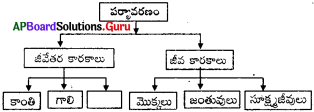
జవాబు:
ఉష్ణోగ్రత
33. ఆహార గొలుసును పూరించండి.
ఉత్పత్తిదారులు → ప్రాథమిక వినియోగదారి → ద్వితీయ వినియోగదారి → అగ్రశ్రేణి వినియోగదారి
జవాబు:
ద్వితీయ వినియోగదారి
34.
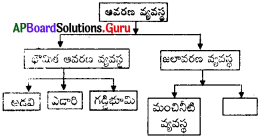
జవాబు:
సముద్ర ఆవరణ వ్యవస్థ
35. గడ్డి → కుందేలు → నక్క → సింహం
పై ఆహార గొలుసులో ద్వితీయ వినియోగదారి ఏది?
జవాబు:
నక్క
36. గడ్డి → కీటకం → కప్ప → పాము → గ్రద్ద
పై ఆహార గొలుసులో అగ్ర వినియోగదారి ఏది?
జవాబు:
గ్రద్ద
37.

జవాబు:
రసాయనిక
37.
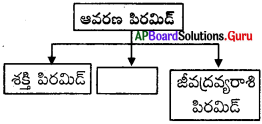
జవాబు:
సంఖ్యా పిరమిడ్
38. నీటి మొక్క → కీటకాలు → [ ] → కొంగ
జవాబు:
చేప
39. క్రింది వానిలో ఏది జలావరణ వ్యవస్థలో జీవ ద్రవ్యరాశి పిరమిడను సూచిస్తుంది?
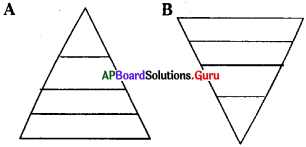
జవాబు:
B
40. జీవ ద్రవ్యరాశి పిరమిడను పూరించండి.
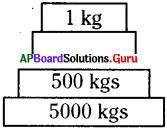
జవాబు:
50 kgs
41. క్రింది వానిలో ఏది పరాన్నజీవుల సంఖ్యా పిరమిడ్ ను సూచిస్తుంది?

జవాబు:
B
10th Class Biology 9th lesson మన పర్యావరణం – మన బాధ్యత 1 Mark Bits Questions and Answers
1. ఈ క్రింది ఆహారపు గొలుసులలో సరైన క్రమము
A) గద్ద → ఎలుక → పాము → ధాన్యం
B) ధాన్యం → ఎలుక → పాము → గద్ద
C) పాము → గద్ద → ఎలుక → ధాన్యం
D) ఎలుక → పాము → ధాన్యం → గద్ద
జవాబు:
B) ధాన్యం → ఎలుక → పాము → గద్ద
2. చార్లెస్ ఎల్టన్ ప్రకారం క్రింది వానిలో సరైన వాక్యం ………….
A) మాంసాహారులు పిరమిడ్ శిఖర భాగంలో ఉంటాయి
B) పిరమిడ్ శిఖర భాగంలో ఎక్కువ శక్తి గ్రహించబడును
C) పిరమిడ్ శిఖర భాగంలో ఉత్పత్తిదారులు ఉండవు
D) A మరియు C
జవాబు:
D) A మరియు C
![]()
3. ఆహారపు గొలుసు దేనితో మొదలౌతుంది?
A) మాంసాహారి
B) ఉత్పత్తిదారు
C) శాకాహారి
D) ఏదీకాదు
జవాబు:
B) ఉత్పత్తిదారు
4. మొక్క → కీటకము – కప్ప → [ ]
A) పాము
B) గుడ్డు
C) పుష్పం
D) ఏదీకాదు
జవాబు:
A) పాము
5. క్రిందివానిలో ప్రాథమిక వినియోగదారులు
A) కుందేలు
B) పులి
C) కప్ప
D) పాము
జవాబు:
A) కుందేలు
6. ఉత్పత్తిదారులు → ప్రాథమిక వినియోగదారులు → ద్వితీయ వినియోగదారులు → తృతీయ వినియోగదారులు
ఈ ఆహారపు గొలుసులో 2లో ఈ జీవి ఉంటుంది.
A) పాము
B) మొక్క
C) మిడుత
D) కప్ప
జవాబు:
C) మిడుత
7. క్రిమిసంహారకాల వాడకాన్ని పూర్తిగా ఆపివేయడం అంటే …………..
A) పురుగుమందుల వాడకంపై పూర్తి నియంత్రణ
B) పురుగుమందుల నిషేధం
C) పర్యావరణ స్నేహపూర్వక వ్యవసాయ పద్ధతులు ప్రోత్సహించడం
D) జీవ రసాయన పరిశ్రమలు మూసివేయడం
జవాబు:
C) పర్యావరణ స్నేహపూర్వక వ్యవసాయ పద్ధతులు ప్రోత్సహించడం
8.

ఖాళీని పూరించడానికి సరియైన దానిని ఎన్నుకోండి.
A)మిడత
B) పాము
C)కప్ప
D) గద్ద
జవాబు:
B) పాము
9. క్రింది పట్టికలో (?) స్థానంలో వుండవలసినది
| పిరమిడ్ రకం | ఆధారం |
| సంఖ్యా పిరమిడ్ | జీవుల సంఖ్య |
| ? | శక్తి పరిమాణం |
A) భౌగోళిక పిరమిడ్
B) శక్తి పిరమిడ్
C) జీవ ద్రవ్యరాశి పిరమిడ్
D) గిజా పిరమిడ్
జవాబు:
B) శక్తి పిరమిడ్
![]()
10. క్రింది పట్టికను పూరింపుము.
| పిరమిడ్ రకం | ఆధారం |
| సంఖ్యా పిరమిడ్ | జీవుల సంఖ్య |
| ……… ? ……. | శక్తి ప్రవాహం |
A) ఆవరణ పిరమిడ్
B) శక్తి పిరమిడ్
C) జీవ ద్రవ్యరాశి పిరమిడ్
D) గిజా పిరమిడ్
జవాబు:
B) శక్తి పిరమిడ్
11. 1958లో చైనా ఏ పక్షులపై దండయాత్ర ప్రకటించింది?
A) చిలుకలు
B) పిచ్చుకలు
C) కాకులు
D) రాబందులు
జవాబు:
B) పిచ్చుకలు
12. నేలలో నత్రజనిని వృద్ధి చేసే మొక్క ఏది?
A) బంతి
B) తుమ్మ
C) గైరిసిడియా
D) కాక్టస్
జవాబు:
C) గైరిసిడియా
13. కింది వానిలో జలావరణ వ్యవస్థ నందు నిటారుగా ఉండని పిరమిడ్
A) సంఖ్యా పిరమిడ్
B) జీవ ద్రవ్యరాశి పిరమిడ్
C) శక్తి పిరమిడ్
D) ఉష్ణ, పిరమిడ్
జవాబు:
B) జీవ ద్రవ్యరాశి పిరమిడ్
![]()
14. కింది వానిలో గ్రీన్హౌస్ వాయువు కానిది ………
A) కార్బన్ డయాక్సెడ్
B) మీథేన్
C) ఓజోన్
D) క్లోరోఫ్లోరో కార్బన్స్
జవాబు:
C) ఓజోన్
15. గీత ఎల్లప్పుడూ మన్నిక గల వస్తువులనే వాడుతుంది, ఎందుకంటే …….
A) వ్యర్థాలను తగ్గించటానికి
B) పునః వినియోగం తగ్గించటానికి
C) పునః చక్రీయం తగ్గించటానికి
D) పునః స్థాపన పెంచటానికి
జవాబు:
A) వ్యర్థాలను తగ్గించటానికి
16. రేణురూప పదార్థాలు గాలిలో చేరుట వల్ల
A) మూత్రపిండాల వ్యాధులు కల్గుతాయి
B) ఆర్గెటీస్ కలుగుతుంది
C) కీళ్ళనొప్పులు కలుగుతాయి.
D) శ్వాసకోశ వ్యాధులు కల్గుతాయి.
జవాబు:
D) శ్వాసకోశ వ్యాధులు కల్గుతాయి.
17. భౌగోళిక వెచ్చదనంను తగ్గించుటకు నీవు పాటించే పద్ధతి
A) ప్లాస్టిక్ ను కాల్చివేయడం
B) విస్తారంగా పశువులు మేపడం
C) శిలాజ ఇంధనాల వాడకం తగ్గించుట
D) ఎ.సి. ల వాడకాన్ని పెంచడం
జవాబు:
C) శిలాజ ఇంధనాల వాడకం తగ్గించుట
18. కింది వాక్యాలలో సరియైనది.
i) పిరమిడ్ ఆధార భాగంలో ఎల్లప్పుడు ఉత్పత్తిదారులే ఉంటారు.
ii) జీవ ద్రవ్యరాశి పిరమిడ్ ఎల్లప్పుడు నిటారుగా ఉంటుంది.
A) (i), (ii) సరియైనవి.
B) (i) మాత్రమే సరియైనది.
C) (ii) మాత్రమే సరియైనది.
D) (i), (ii) లు సరియైనవి కావు.
జవాబు:
B) (i) మాత్రమే సరియైనది.
19. దేనికోసం మొక్కలు పోటీ పడతాయి?
(i) నీరు (ii) ఆహారం (iii) స్థలం
A) (i) మరియు (ii)
B) (ii) మరియు (iii)
C) (i) మరియు (iii)
D) (i), (ii) మరియు (iii)
జవాబు:
C) (i) మరియు (iii)
20. పంటలు పండించడానికి సరియైన పద్దతి కానిది
A) పంట మార్పిడి
B) జైవిక నియంత్రణ
C) మిశ్రమ పంటలు పండించడం
D) రసాయన ఎరువులు, పురుగు మందులు ఉపయోగించడం
జవాబు:
D) రసాయన ఎరువులు, పురుగు మందులు ఉపయోగించడం
21. ఎల్లప్పుడు ఆహారపు గొలుసు దేనితో మొదలవుతుంది?
A) శాకాహారులు
B) మాంసాహారులు
C) ఉత్పత్తిదారులు
D) ఏదీకాదు
జవాబు:
C) ఉత్పత్తిదారులు
![]()
22. జీవావరణ పిరమిడ్లకు సంబంధించి సరయిన వాక్యం
A) సంఖ్యా పిరమిడ్ నిర్మాణం ఏ విధంగా ఉన్నా ఉత్పత్తి దారులు పై భాగంలో ఉంటాయి.
B) చార్లెస్ ఎల్టన్ జీవావరణ పిరమిడ్ల రేఖాచిత్రాలను మొదటగా ప్రవేశపెట్టాడు.
C) సాధారణంగా సంఖ్యా పిరమిడ్ లాగే జీవ ద్రవ్యరాశి పిరమిడ్ ఉంటుంది.
D)ఒక పోషకస్థాయి నుండి మరొక పోషకస్థాయి జీవులకు శక్తి పూర్తిగా చేరుతుంది.
జవాబు:
B) చార్లెస్ ఎల్టన్ జీవావరణ పిరమిడ్ల రేఖాచిత్రాలను మొదటగా ప్రవేశపెట్టాడు.
మీకు తెలుసా?
• పిరమిడ్ నిర్మాణం జ్యామితీయ ఆకృతిలో ఉంటుంది. బయటి ఉపరితలాలు త్రిభుజాకారంలో ఉండి వాటి చివరలు పై కొనలో కలుస్తాయి. పిరమిడ్ అడుగుభాగం త్రిముఖీయంగా లేదా చతుర్ముఖీయంగా లేదా బహుముఖీయ ఆకారంలో ఉంటుంది. చతురస్రాకార పిరమిడ్ల చతురస్రాకారంగా ఉండి బయటి ఉపరితలాలు మాత్రం త్రిభుజాకారంలో ఉంటాయి. సాధారణంగా పిరమిడ్ లో ఈ ఆకృతిలోనే ఉంటాయి.
• శిలాజ ఇంధనాలపై (భూమిలో మృత కళేబరాల అవాయు విచ్ఛిన్న క్రియ ద్వారా ఏర్పడిన పెట్రోలియం, బొగ్గు మొదలైన ఇంధనాలు) మనం ఆధారపడటాన్ని తగ్గించడానికి, గాలి కాలుష్యాన్ని తగ్గించడానికి, జీవ ద్రవ్యరాశిని కూడా ఒక ఇంధన వనరుగా వినియోగించవచ్చును. జీవ ద్రవ్యరాశిని ఇంధనంగా వాడినపుడు కూడా కార్బన్ డై ఆక్సైడ్ విడుదలవుతుంది. కానీ, అది జీవ ద్రవ్యరాశి ఏర్పడటానికి, తిరిగి గాలి నుండి గ్రహించబడుతుంది.
• మినిమేటా వ్యాధిని మొదట 1956వ సంవత్సరంలో జపాన్లోని కుమమోటో ఎఫెక్చర్ లో గల మిమిమేటా నగరంలో కనుగొన్నారు. 1932 నుండి 1968 వరకు చిస్సో కార్పొరేషన్ వారి రసాయన పరిశ్రమ నుండి విడుదలైన మిథైల్ మెర్క్యురీతో కూడిన వ్యర్థజలాలే, మినిమేటా వ్యాధికి కారణం. షిరని సముద్రం (Shiranui sea) మినిమేటా అఖాతంలో ఉండే చేపల ద్వారా వీటిని తినే స్థానిక మనుషుల్లోకి మిథైల్ మెర్క్యురీ చేరి అనారోగ్యాలకు దారితీసింది. ఫలితంగా పిల్లులు, కుక్కలు, పందులు, మనుషుల మరణాలు 36 ఏళ్ళుగా కొనసాగాయి.
పునశ్చరణ
